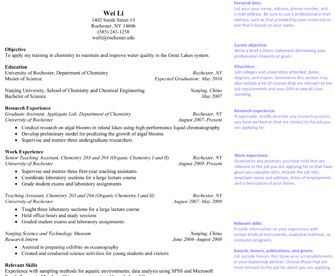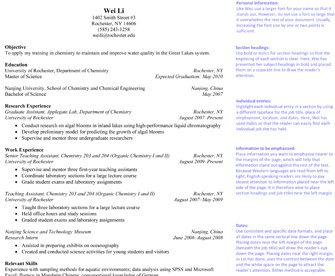« Prev Next »

Résumés
Choosing your structure and content
When you apply for a job, you will most likely submit a résumé along with your job letter. A résumé, sometimes called a curriculum vitae or CV, is a summary of your education, work experience, and accomplishments. Employers use résumés to decide whether to interview you for a job, and proposal reviewers use résumés to decide whether you are qualified to do the proposed work. Therefore, in your résumé, you should highlight those attributes most relevant to your particular audience.
Reviewers often read résumés in less than a minute; therefore, structure your résumé so that your outstanding characteristics are easy to see. Be sure to include specific phrases that match the terms listed in the job ad. Doing so shows the reader that you understand what the position involves and have tailored your application to meet its requirements.If possible, keep your résumé to one page. If, however, you have several publications or a great deal of relevant work experience, you may have to use two pages. A standard résumé typically includes multiple sections, as illustrated in the example to the right.
Writing a career objective
As illustrated on the previous screen, after your personal data, your career objective is the first section readers will see on your résumé. Your objective should offer a succinct, specific statement indicating what field of work you are seeking. Avoid clichés, wordiness, jargon, and inflated prose.
The following is an example of a poorly crafted career objective:
This example is problematic because it is full of redundant phrases like "honed and developed" and other boastful, broad statements about ability like "my leadership and vision." An objective statement should not brag about your skills: The recruiter will determine how valuable your skills are during the interview. Also, unlike the author of this statement, you should not include rewards as an objective, as that suggests overconfidence in your abilities. Instead, your objective line should stick to the facts: It should go directly to the type of position you seek.
Now, consider a second objective that is much more appropriate to the situation:
Note that this example is more succinct and specific than the weak example. Here, the author refers to his or her background without bragging about his or her abilities. The author also notes his or her interest in water quality, which shows the reader that the author's interests overlap with the organization's research.
In some cases, you might even tailor your objective statement to one particular job advertisement, as in the following example:
In this objective, the author has identified a very specific goal: to work in a certain capacity for a certain company. This shows that the author has taken the time to tailor his or her résumé to fit one particular job announcement.
Note that in the last two examples, the objective statements do not make any claims about the quality of the applicant's abilities. Instead, they simply help the recruiter decide if the applicant knows what he or she wants. Some recruiters skim the objective line to determine whether you have applied for the right job. These individuals look for specific information and key terms from the job ad as evidence that your résumé has come to the right place.
Presenting your education
When drafting a résumé, most recent graduates place their education in a section before their employment history, especially if they are earning their degree from a prestigious university that carries weight with employers. Regardless of the exact placement of your educational information, you should present the schools you have attended in reverse chronological order, with your most recent degrees listed first. If you have attended four or more different universities, consider listing only the ones from which you have earned degrees. For instance, in the sample résumé shown earlier, Wei Li presents her education like this:
Here, Wei lists each of the universities she attended, her area of study, and the degrees she received. Note that the location of these universities and the dates she received each degree are flush with the right margin so they stand out to the reader.
If you have very little relevant work experience, try to add substance to your résumé in the educational history section. Consider listing relevant courses, particularly those that relate to the job you are applying for. You might also provide details about specific projects you worked on during your undergraduate training. For example:
The format here is different than in the previous examples, but the important information is still clear. Note that the author has organized this list so that related courses are grouped; this approach can help you highlight areas in which you have special experience.
Presenting your experience
As with your education, you should list your research and work experience in reverse chronological order, placing your most recent job first. If you have research experience that is directly relevant to the job you are applying for, place that information before your work experience. Include some detail about the project and your responsibilities, but leave longer discussion of the project for the job letter. If you have used specialized equipment or analytical methods as part of your research, mention those skills as well.
When describing your work experience, be sure to include your job title and place of employment. Follow the corporation or organization with the city and appropriate state, province, or country. Consider listing your supervisor's name (if possible and prudent). Then include a bulleted list of duties you performed at that job. For jobs you held in the past, use active past tense verbs at the beginning of each item in the list. For jobs you currently hold, use active present tense. Make sure that your lists are parallel — that is, if the first item of your list begins with a verb, then all the items in the list should begin with a verb. All the verbs within a single entry also should be the same tense.
In the example below, the author has not written a parallel list:
This list is not parallel because two of the items begin with verbs ("designed," "supervise") and one begins with a noun ("skill"). If the author used certain methods to perform certain kinds of data analysis, he or she should note this by a phrase that begins with a verb. Furthermore, the verbs are in two different tenses: "Designed" suggests that this is a responsibility the author held in the past, but "supervise and mentor" indicate that these are activities in which the author currently participates.
Consider organizing your employment history into two different categories — "Relevant Employment" and "Other Employment" — if you have numerous jobs that make your résumé longer than one page. Keep the "Relevant Employment" section on the first page. Keep in mind, of course, that too much detail can increase the length of a résumé. Employers do not always take time to read the second pages of résumés, so your first page should highlight your most important information. Also, be sure to put your most relevant experience and educational details as close to the top of the first page as possible.
For example, consider how Wei Li has presented her
research experience before her work experience. This will help the reader see
her skills and techniques that apply most directly to the organization's own
research.
Note that all the items in Wei's lists are parallel — each item begins with a verb, and the verbs are all in the same tense.
Formatting your resume
Because readers often scan a résumé quickly, the format you use influences how easily they find important information. Your task, then, is to make key details stand out while still following a professional format.
Using fancy or novelty fonts makes reading difficult, and it may prompt recruiters to question whether you are serious about your career. Instead, use fonts that are easy to read, such as Times New Roman or Arial. Although it may be appropriate to print your cover letter and résumé on paper made especially for professional correspondence, avoid using colored paper, paper with graphics, or cardstock for your application. These tricks may lead your reader to think you spent more time making your application pretty than you did preparing the content.Proofread your résumé carefully to avoid careless errors in spelling, grammar, or format. These errors will suggest that you do not pay attention to detail or that you complete work in a hurry — qualities that employers want to avoid.
Consider how Wei Li has formatted her résumé (right).
Using a professional tone
Your résumé should be as objective and specific as possible in its tone. You can accomplish this best in the bullet points made after each job listing, where you provide brief details about the work you did. Do not add unverifiable information: Instead of writing "Efficiently and effectively used excellent communication skills to manage a cross-functional team in designing a superior, innovative, and inexpensive ventilator system for the X-5000," write "Managed a cross-functional team in designing a new ventilator system for the X-5000." Do not make sweeping claims about your creativity, excellence, and effectiveness: Recruiters will judge you for themselves when they interview you.
Instead of making sweeping value claims about yourself, try to include word choices that mirror the key words included in the job ad. As you choose details to emphasize in your résumé, be as accurate, forthright, and truthful as you can be. Employers will often verify your information online or by calling companies or institutions with whom you have worked. Likewise, if you express proficiency in a foreign language, be prepared to demonstrate that proficiency in the interview — especially if you are applying to an international or global organization. In short, do not ruin your chances with an employer by offering misinformation or deliberately attempting to "sell" yourself as having qualifications you do not possess.

Within this Subject (22)






























